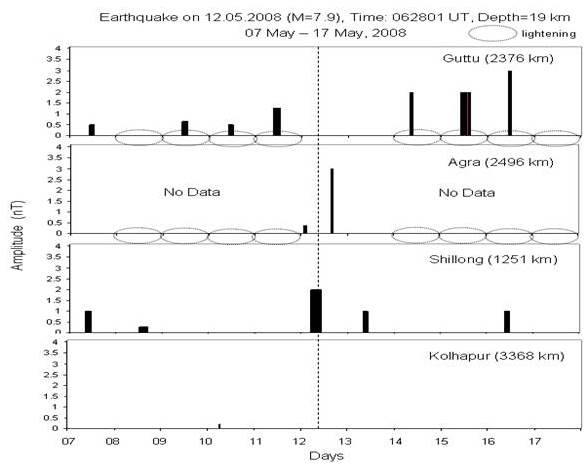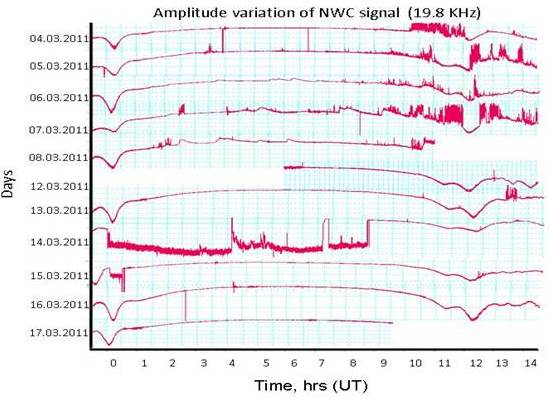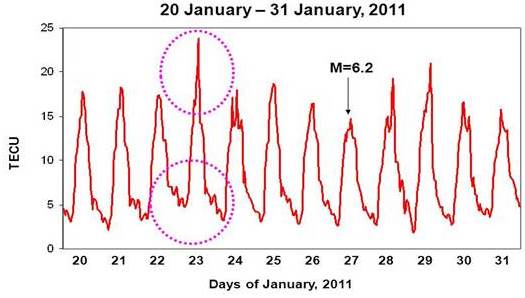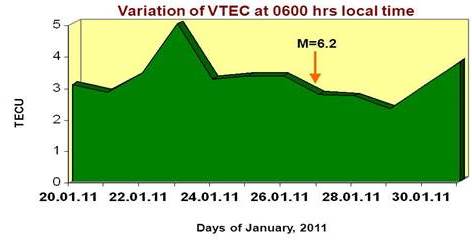Multistation ULF measurements
Ground based observations have been carried out for Ultra Low Frequency (ULF) precursors of earthquakes at four different stations in India namely Agra (Geograph.Lat 270 N, long. 780 E), Guttu (lat 31.530 N, long 78.750 E), Shillong (lat. 25.920 N, long. 91.880 E) and Kolhapur (lat 16.400 N, long 74.150 E) using identical 3-component search coil magnetometers (f = 0.01-30 Hz) obtained from Lviv center of space research Ukraine. An offline analysis of the combined data has been carried out in relation to a major earthquake of magnitude M=7.9 occurred in the neighboring country China under the National Program of Earthquakes Precursors (NPEP) launched in India since May, 2009. The results of the analysis show occurrence of amplitude anomalies as precursors whose amplitudes decrease with distance. The precursory periods range between 2 and 5 days and are large for the stations nearer to epicenter. A graphical determination of location of the epicenter is found to be satisfactory with errors within about 20.5%. Further, the TEC data for a period of 03 months from 01 April to 30 June, 2008 have been analyzed and the results show enhancement in TEC 22 days before the occurrence of Wenchuan earthquake.
However, since the Ultra Low Frequency (ULF) band (0.01- 10Hz) which is characterized by large skin depth, low attenuation and less contamination from other sources can penetrate the crust and propagate in the atmosphere, ionosphere, and magnetosphere is considered to provide much convincing precursors of earthquakes on the ground and satellite. In Fig.4 the ULF data for all stations are shown on a 10 days plot (± 5 days from the day of earthquake shown by vertical dashed line). Other details can be seen from the Figure itself.

b. Occurrence pattern of amplitude bursts at the observing stations of Guttu, Agra,
ULF data obtained at Guttu, Agra and Shillong.
Termination Time anomalies (Tsunami in Japan)
Termination time technique has been employed to process the amplitude data of 19.8 kHz (NWC) subionospheric VLF transmitter signals monitored at Agra (Lat. 27.20 N, long. 780 E), India, using SoftPAL receiver. The results show (Fig.5) that there are practically no shifts in sunrise and sunset termination times prior to the earthquakes of 11 March, 2011 (M = 8.9, tsunami). However, there is an evidence of disappearance of sunrise time on 14 March, 2011. Possibly due to late arrival of the effect of disturbance around the great circle path (GCP) between the locations of the source in Australia and receiver of the NWC signal at Agra station.

VLF observation during tsunami in Japan (11 March, 2011)
TEC anomalies during earthquakes
We have examined the effect of earthquakes on total electron content (TEC) data at Agra (Geographic Lat. 27.20N, Long. 780E), India. We have carried out this study for the period of 18 months from 01 January, 2009 to 30 June, 2011 and a dual frequency GPS receiver system is used for recording TEC data. To investigate the seismic effects on TEC, we have selected an epicentral distance of 2000 km from the observing station. This region includes 22 cases of earthquakes in the period of study with large magnitudes (M≥5.5). Different statistical procedures are used to observe the anomalies in TEC data. The results show that TEC fluctuated in the form of enhancements and depletion and maximum precursors are found 5-10 days prior to these earthquakes (see Fig.6). We have also studied the solar and geomagnetic activities during the cases of earthquakes and data on disturbed days are omitted to separate out the seismic effects. Hence, the observed TEC anomalies may be due to the occurrences of large magnitude earthquakes around Indian region. The E×B drift due to the electric field generation during earthquake preparation process and ground wave oscillations may be the significant contributors of these anomalies in TEC data.

Variation of TEC during 20-31 January, 2011. Anomalies in the data are encircled.

Variation of TEC data during 20 January-31 January, 2011 at 0600hrs LT.
